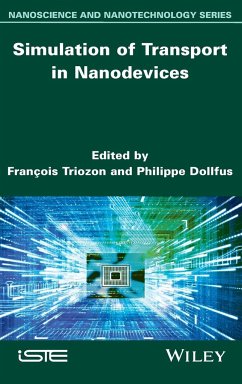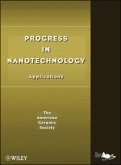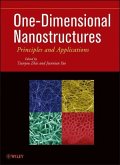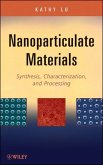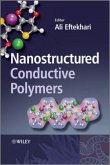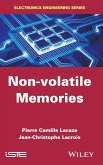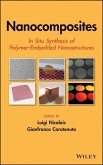Simulation of Transport in Nanodevices
Herausgegeben von Triozon, François; Dollfus, Philippe
Simulation of Transport in Nanodevices
Herausgegeben von Triozon, François; Dollfus, Philippe
- Gebundenes Buch
- Merkliste
- Auf die Merkliste
- Bewerten Bewerten
- Teilen
- Produkt teilen
- Produkterinnerung
- Produkterinnerung
Linear current-voltage pattern, has been and continues to be the basis for characterizing, evaluating performance, and designing integrated circuits, but is shown not to hold its supremacy as channel lengths are being scaled down. In a nanoscale circuit with reduced dimensionality in one or more of the three Cartesian directions, quantum effects transform the carrier statistics. In the high electric field, the collision free ballistic transform is predicted, while in low electric field the transport remains predominantly scattering-limited. In a micro/nano-circuit, even a low logic voltage of…mehr
Andere Kunden interessierten sich auch für
![Progress in Nanotechnology Progress in Nanotechnology]() Progress in Nanotechnology224,99 €
Progress in Nanotechnology224,99 €![One-Dimensional Nanostructures One-Dimensional Nanostructures]() Tianyou ZhaiOne-Dimensional Nanostructures193,99 €
Tianyou ZhaiOne-Dimensional Nanostructures193,99 €![Nanoparticulate Materials Nanoparticulate Materials]() K. LuNanoparticulate Materials193,99 €
K. LuNanoparticulate Materials193,99 €![Nanostructured Conductive Polymers Nanostructured Conductive Polymers]() Nanostructured Conductive Polymers329,99 €
Nanostructured Conductive Polymers329,99 €![Non-Volatile Memories Non-Volatile Memories]() Pierre-Camille LacazeNon-Volatile Memories186,99 €
Pierre-Camille LacazeNon-Volatile Memories186,99 €![Nanocomposites Nanocomposites]() Luigi NicolaisNanocomposites127,99 €
Luigi NicolaisNanocomposites127,99 €![Green Metal Nanoparticles Green Metal Nanoparticles]() Green Metal Nanoparticles300,99 €
Green Metal Nanoparticles300,99 €-
-
-
Linear current-voltage pattern, has been and continues to be the basis for characterizing, evaluating performance, and designing integrated circuits, but is shown not to hold its supremacy as channel lengths are being scaled down. In a nanoscale circuit with reduced dimensionality in one or more of the three Cartesian directions, quantum effects transform the carrier statistics. In the high electric field, the collision free ballistic transform is predicted, while in low electric field the transport remains predominantly scattering-limited. In a micro/nano-circuit, even a low logic voltage of 1 V is above the critical voltage triggering nonohmic behavior that results in ballistic current saturation. A quantum emission may lower this ballistic velocity.
Hinweis: Dieser Artikel kann nur an eine deutsche Lieferadresse ausgeliefert werden.
Hinweis: Dieser Artikel kann nur an eine deutsche Lieferadresse ausgeliefert werden.
Produktdetails
- Produktdetails
- Verlag: Wiley & Sons
- 1. Auflage
- Seitenzahl: 228
- Erscheinungstermin: 12. Februar 2016
- Englisch
- Abmessung: 240mm x 161mm x 26mm
- Gewicht: 762g
- ISBN-13: 9781848215665
- ISBN-10: 1848215665
- Artikelnr.: 38542084
- Herstellerkennzeichnung
- Libri GmbH
- Europaallee 1
- 36244 Bad Hersfeld
- gpsr@libri.de
- Verlag: Wiley & Sons
- 1. Auflage
- Seitenzahl: 228
- Erscheinungstermin: 12. Februar 2016
- Englisch
- Abmessung: 240mm x 161mm x 26mm
- Gewicht: 762g
- ISBN-13: 9781848215665
- ISBN-10: 1848215665
- Artikelnr.: 38542084
- Herstellerkennzeichnung
- Libri GmbH
- Europaallee 1
- 36244 Bad Hersfeld
- gpsr@libri.de
François Triozon, Researcher at Laboratoire d'Electronique et de Technologies de l'Information (LETI) of CEA/Grenoble, France. Philippe Dollfus, CNRS Research Director, France.
Preface xiii
List of Symbols xv
List of Abbreviations xvii
Chapter 1 Introduction: Nanoelectronics, Quantum Mechanics, and Solid State
Physics 1
Philippe Dollfus and François Triozon
1.1 Nanoelectronics 1
1.2 Basic notions of solid-state physics 4
1.3 Quantum mechanics and electronic transport 20
1.4 Conclusion 29
1.5 Bibliography 30
Chapter 2 Electronic Transport: Electrons, Phonons and Their Coupling
within the Density Functional Theory 31
Nathalie Vast, Jelena Sjakste, Gaston Kané and Virginie Trinité
2.1 Introduction 31
2.2 Electronic structure 34
2.3 Phonons 46
2.4 Electron-phonon coupling 52
2.5 Semiclassical transport properties 62
2.6 Quantum transport 70
2.7 Conclusion 84
2.8 Appendix A 85
2.9 Blbiography 86
Chapter 3 Electronic Band Structure: Empirical Pseudopotentials, k . p and
Tight-Binding Methods 97
Denis Rideau, François Triozon and Philippe Dollfus
3.1 Band structure problem 97
3.2 Empirical pseudopotentials method 102
3.3 the k . p method 109
3.4 The TB method 115
3.5 Optimization of empirical models 122
3.6 Bibliography 126
Chapter 4 Relevant Semiempirical Potentials for Phonon Properties 131
Sebastian Volz
4.1 Introduction 131
4.2 Generic pair potentials: the Lennard-Jones potential 134
4.3 Semiconductors: Stillinger-Weber and Tersoff potentials 136
4.4 Oxydes: Van Beest, Kramer and van Santen potential 143
4.5 Metals - isotropic many-body pair-functional potentials for metals: the
modified embedded-atom method 148
4.6 Polymers and carbon-based compounds: adaptive intermolecular reactive
bond order, adaptive intermolecular REBO and Dreiding potentials 149
4.7 Water: TIP3P potential 156
4.8 Conclusion 158
4.9 Bibliography 158
Chapter 5 Introduction to Quantum Transport 163
François Triozon, Stephan Roche and Yann-Michel Niquet
5.1 Quantum transport from the point of view of wavepacket propagation 164
5.2 The transmission formalism for the conductance 177
5.3 The Green's function method for quantum transmission 185
5.4 Conclusion 219
5.5 Matlab/Octave codes 219
5.6 Bibliography 220
Chapter 6 Non-Equilibrium Green's Function Formalism 223
Michel Lannoo and Marc Bescond
6.1 Second quantization and time evolution pictures 223
6.2 General definition of the Green's functions, their physical meaning and
their perturbation expansion 225
6.3 Stationary Green's functions and fluctuation-dissipation theorem 229
6.4 Dyson's equation and self-energy: general formulation 232
6.5 Some examples 237
6.6 The ballistic regime 240
6.7 The electron-photon interaction 245
6.8 Bibliography 257
Chapter 7 Electron Devices Simulation with Bohmian Trajectories 261
Guillermo Albareda, Damiano Marian, Abdelilah Benali, Alfonso Alarcon,
Simeon Moises and Xavier Oriols
7.1 Introduction: why Bohmian mechanics? 261
7.2 Theoretical framework: Bohmian mechanics 267
7.3 The BITLLES simulator: time-resolved electron transport 276
7.4 Computation of the electrical current and its moments with BITLLES 291
7.5 Conclusion 299
7.6 Acknowlegments 301
7.7 Appendix A: Pratical algorithm to compute Bohmian trajectories 301
7.8 Appendix B: Ramo-Shockley-Pellegrini theorems 306
7.9 Appendix C: Bohmian mechanics with operators 307
7.10 Appendix D: Relation between the Wigner distribution function and the
Bohmian trajectories 310
7.11 Bibliography 314
Chapter 8 The Monte Carlo Method for Wigner and Boltzmann Transport
Equations 319
Philippe Dollfus, Damien Querlioz and Jérôme Saint Martin
8.1 The WTE 320
8.2 The semiclassical limit: BTE 325
8.3 Scattering in Boltzmann and Wigner equations 329
8.4 The MC method for solving the BTE 341
8.5 Extension of the MC method for solving the WBTE 352
8.6 Bibliography 360
List of Authors 371
Index 373
List of Symbols xv
List of Abbreviations xvii
Chapter 1 Introduction: Nanoelectronics, Quantum Mechanics, and Solid State
Physics 1
Philippe Dollfus and François Triozon
1.1 Nanoelectronics 1
1.2 Basic notions of solid-state physics 4
1.3 Quantum mechanics and electronic transport 20
1.4 Conclusion 29
1.5 Bibliography 30
Chapter 2 Electronic Transport: Electrons, Phonons and Their Coupling
within the Density Functional Theory 31
Nathalie Vast, Jelena Sjakste, Gaston Kané and Virginie Trinité
2.1 Introduction 31
2.2 Electronic structure 34
2.3 Phonons 46
2.4 Electron-phonon coupling 52
2.5 Semiclassical transport properties 62
2.6 Quantum transport 70
2.7 Conclusion 84
2.8 Appendix A 85
2.9 Blbiography 86
Chapter 3 Electronic Band Structure: Empirical Pseudopotentials, k . p and
Tight-Binding Methods 97
Denis Rideau, François Triozon and Philippe Dollfus
3.1 Band structure problem 97
3.2 Empirical pseudopotentials method 102
3.3 the k . p method 109
3.4 The TB method 115
3.5 Optimization of empirical models 122
3.6 Bibliography 126
Chapter 4 Relevant Semiempirical Potentials for Phonon Properties 131
Sebastian Volz
4.1 Introduction 131
4.2 Generic pair potentials: the Lennard-Jones potential 134
4.3 Semiconductors: Stillinger-Weber and Tersoff potentials 136
4.4 Oxydes: Van Beest, Kramer and van Santen potential 143
4.5 Metals - isotropic many-body pair-functional potentials for metals: the
modified embedded-atom method 148
4.6 Polymers and carbon-based compounds: adaptive intermolecular reactive
bond order, adaptive intermolecular REBO and Dreiding potentials 149
4.7 Water: TIP3P potential 156
4.8 Conclusion 158
4.9 Bibliography 158
Chapter 5 Introduction to Quantum Transport 163
François Triozon, Stephan Roche and Yann-Michel Niquet
5.1 Quantum transport from the point of view of wavepacket propagation 164
5.2 The transmission formalism for the conductance 177
5.3 The Green's function method for quantum transmission 185
5.4 Conclusion 219
5.5 Matlab/Octave codes 219
5.6 Bibliography 220
Chapter 6 Non-Equilibrium Green's Function Formalism 223
Michel Lannoo and Marc Bescond
6.1 Second quantization and time evolution pictures 223
6.2 General definition of the Green's functions, their physical meaning and
their perturbation expansion 225
6.3 Stationary Green's functions and fluctuation-dissipation theorem 229
6.4 Dyson's equation and self-energy: general formulation 232
6.5 Some examples 237
6.6 The ballistic regime 240
6.7 The electron-photon interaction 245
6.8 Bibliography 257
Chapter 7 Electron Devices Simulation with Bohmian Trajectories 261
Guillermo Albareda, Damiano Marian, Abdelilah Benali, Alfonso Alarcon,
Simeon Moises and Xavier Oriols
7.1 Introduction: why Bohmian mechanics? 261
7.2 Theoretical framework: Bohmian mechanics 267
7.3 The BITLLES simulator: time-resolved electron transport 276
7.4 Computation of the electrical current and its moments with BITLLES 291
7.5 Conclusion 299
7.6 Acknowlegments 301
7.7 Appendix A: Pratical algorithm to compute Bohmian trajectories 301
7.8 Appendix B: Ramo-Shockley-Pellegrini theorems 306
7.9 Appendix C: Bohmian mechanics with operators 307
7.10 Appendix D: Relation between the Wigner distribution function and the
Bohmian trajectories 310
7.11 Bibliography 314
Chapter 8 The Monte Carlo Method for Wigner and Boltzmann Transport
Equations 319
Philippe Dollfus, Damien Querlioz and Jérôme Saint Martin
8.1 The WTE 320
8.2 The semiclassical limit: BTE 325
8.3 Scattering in Boltzmann and Wigner equations 329
8.4 The MC method for solving the BTE 341
8.5 Extension of the MC method for solving the WBTE 352
8.6 Bibliography 360
List of Authors 371
Index 373
Preface xiii
List of Symbols xv
List of Abbreviations xvii
Chapter 1 Introduction: Nanoelectronics, Quantum Mechanics, and Solid State
Physics 1
Philippe Dollfus and François Triozon
1.1 Nanoelectronics 1
1.2 Basic notions of solid-state physics 4
1.3 Quantum mechanics and electronic transport 20
1.4 Conclusion 29
1.5 Bibliography 30
Chapter 2 Electronic Transport: Electrons, Phonons and Their Coupling
within the Density Functional Theory 31
Nathalie Vast, Jelena Sjakste, Gaston Kané and Virginie Trinité
2.1 Introduction 31
2.2 Electronic structure 34
2.3 Phonons 46
2.4 Electron-phonon coupling 52
2.5 Semiclassical transport properties 62
2.6 Quantum transport 70
2.7 Conclusion 84
2.8 Appendix A 85
2.9 Blbiography 86
Chapter 3 Electronic Band Structure: Empirical Pseudopotentials, k . p and
Tight-Binding Methods 97
Denis Rideau, François Triozon and Philippe Dollfus
3.1 Band structure problem 97
3.2 Empirical pseudopotentials method 102
3.3 the k . p method 109
3.4 The TB method 115
3.5 Optimization of empirical models 122
3.6 Bibliography 126
Chapter 4 Relevant Semiempirical Potentials for Phonon Properties 131
Sebastian Volz
4.1 Introduction 131
4.2 Generic pair potentials: the Lennard-Jones potential 134
4.3 Semiconductors: Stillinger-Weber and Tersoff potentials 136
4.4 Oxydes: Van Beest, Kramer and van Santen potential 143
4.5 Metals - isotropic many-body pair-functional potentials for metals: the
modified embedded-atom method 148
4.6 Polymers and carbon-based compounds: adaptive intermolecular reactive
bond order, adaptive intermolecular REBO and Dreiding potentials 149
4.7 Water: TIP3P potential 156
4.8 Conclusion 158
4.9 Bibliography 158
Chapter 5 Introduction to Quantum Transport 163
François Triozon, Stephan Roche and Yann-Michel Niquet
5.1 Quantum transport from the point of view of wavepacket propagation 164
5.2 The transmission formalism for the conductance 177
5.3 The Green's function method for quantum transmission 185
5.4 Conclusion 219
5.5 Matlab/Octave codes 219
5.6 Bibliography 220
Chapter 6 Non-Equilibrium Green's Function Formalism 223
Michel Lannoo and Marc Bescond
6.1 Second quantization and time evolution pictures 223
6.2 General definition of the Green's functions, their physical meaning and
their perturbation expansion 225
6.3 Stationary Green's functions and fluctuation-dissipation theorem 229
6.4 Dyson's equation and self-energy: general formulation 232
6.5 Some examples 237
6.6 The ballistic regime 240
6.7 The electron-photon interaction 245
6.8 Bibliography 257
Chapter 7 Electron Devices Simulation with Bohmian Trajectories 261
Guillermo Albareda, Damiano Marian, Abdelilah Benali, Alfonso Alarcon,
Simeon Moises and Xavier Oriols
7.1 Introduction: why Bohmian mechanics? 261
7.2 Theoretical framework: Bohmian mechanics 267
7.3 The BITLLES simulator: time-resolved electron transport 276
7.4 Computation of the electrical current and its moments with BITLLES 291
7.5 Conclusion 299
7.6 Acknowlegments 301
7.7 Appendix A: Pratical algorithm to compute Bohmian trajectories 301
7.8 Appendix B: Ramo-Shockley-Pellegrini theorems 306
7.9 Appendix C: Bohmian mechanics with operators 307
7.10 Appendix D: Relation between the Wigner distribution function and the
Bohmian trajectories 310
7.11 Bibliography 314
Chapter 8 The Monte Carlo Method for Wigner and Boltzmann Transport
Equations 319
Philippe Dollfus, Damien Querlioz and Jérôme Saint Martin
8.1 The WTE 320
8.2 The semiclassical limit: BTE 325
8.3 Scattering in Boltzmann and Wigner equations 329
8.4 The MC method for solving the BTE 341
8.5 Extension of the MC method for solving the WBTE 352
8.6 Bibliography 360
List of Authors 371
Index 373
List of Symbols xv
List of Abbreviations xvii
Chapter 1 Introduction: Nanoelectronics, Quantum Mechanics, and Solid State
Physics 1
Philippe Dollfus and François Triozon
1.1 Nanoelectronics 1
1.2 Basic notions of solid-state physics 4
1.3 Quantum mechanics and electronic transport 20
1.4 Conclusion 29
1.5 Bibliography 30
Chapter 2 Electronic Transport: Electrons, Phonons and Their Coupling
within the Density Functional Theory 31
Nathalie Vast, Jelena Sjakste, Gaston Kané and Virginie Trinité
2.1 Introduction 31
2.2 Electronic structure 34
2.3 Phonons 46
2.4 Electron-phonon coupling 52
2.5 Semiclassical transport properties 62
2.6 Quantum transport 70
2.7 Conclusion 84
2.8 Appendix A 85
2.9 Blbiography 86
Chapter 3 Electronic Band Structure: Empirical Pseudopotentials, k . p and
Tight-Binding Methods 97
Denis Rideau, François Triozon and Philippe Dollfus
3.1 Band structure problem 97
3.2 Empirical pseudopotentials method 102
3.3 the k . p method 109
3.4 The TB method 115
3.5 Optimization of empirical models 122
3.6 Bibliography 126
Chapter 4 Relevant Semiempirical Potentials for Phonon Properties 131
Sebastian Volz
4.1 Introduction 131
4.2 Generic pair potentials: the Lennard-Jones potential 134
4.3 Semiconductors: Stillinger-Weber and Tersoff potentials 136
4.4 Oxydes: Van Beest, Kramer and van Santen potential 143
4.5 Metals - isotropic many-body pair-functional potentials for metals: the
modified embedded-atom method 148
4.6 Polymers and carbon-based compounds: adaptive intermolecular reactive
bond order, adaptive intermolecular REBO and Dreiding potentials 149
4.7 Water: TIP3P potential 156
4.8 Conclusion 158
4.9 Bibliography 158
Chapter 5 Introduction to Quantum Transport 163
François Triozon, Stephan Roche and Yann-Michel Niquet
5.1 Quantum transport from the point of view of wavepacket propagation 164
5.2 The transmission formalism for the conductance 177
5.3 The Green's function method for quantum transmission 185
5.4 Conclusion 219
5.5 Matlab/Octave codes 219
5.6 Bibliography 220
Chapter 6 Non-Equilibrium Green's Function Formalism 223
Michel Lannoo and Marc Bescond
6.1 Second quantization and time evolution pictures 223
6.2 General definition of the Green's functions, their physical meaning and
their perturbation expansion 225
6.3 Stationary Green's functions and fluctuation-dissipation theorem 229
6.4 Dyson's equation and self-energy: general formulation 232
6.5 Some examples 237
6.6 The ballistic regime 240
6.7 The electron-photon interaction 245
6.8 Bibliography 257
Chapter 7 Electron Devices Simulation with Bohmian Trajectories 261
Guillermo Albareda, Damiano Marian, Abdelilah Benali, Alfonso Alarcon,
Simeon Moises and Xavier Oriols
7.1 Introduction: why Bohmian mechanics? 261
7.2 Theoretical framework: Bohmian mechanics 267
7.3 The BITLLES simulator: time-resolved electron transport 276
7.4 Computation of the electrical current and its moments with BITLLES 291
7.5 Conclusion 299
7.6 Acknowlegments 301
7.7 Appendix A: Pratical algorithm to compute Bohmian trajectories 301
7.8 Appendix B: Ramo-Shockley-Pellegrini theorems 306
7.9 Appendix C: Bohmian mechanics with operators 307
7.10 Appendix D: Relation between the Wigner distribution function and the
Bohmian trajectories 310
7.11 Bibliography 314
Chapter 8 The Monte Carlo Method for Wigner and Boltzmann Transport
Equations 319
Philippe Dollfus, Damien Querlioz and Jérôme Saint Martin
8.1 The WTE 320
8.2 The semiclassical limit: BTE 325
8.3 Scattering in Boltzmann and Wigner equations 329
8.4 The MC method for solving the BTE 341
8.5 Extension of the MC method for solving the WBTE 352
8.6 Bibliography 360
List of Authors 371
Index 373

